Related Research Articles
Maundy Thursday or Holy Thursday is the day during Holy Week that commemorates the Washing of the Feet (Maundy) and Last Supper of Jesus Christ with the Apostles, as described in the canonical gospels.

Holy Week is the most sacred week in the liturgical year in Christianity. For all Christian traditions, it is a moveable observance. In Eastern Christianity, which also calls it Great Week, it is the week following Great Lent and Lazarus Saturday, starting on the evening of Palm Sunday and concluding on the evening of Great Saturday. In Western Christianity, Holy Week is the sixth and last week of Lent, beginning with Palm Sunday and concluding on Holy Saturday.
In Christian liturgy, the credo is the Nicene-Constantinopolitan Creed – or its shorter version, the Apostles' Creed – in the Mass, either as a prayer, a spoken text, or sung as Gregorian chant or other musical settings of the Mass.
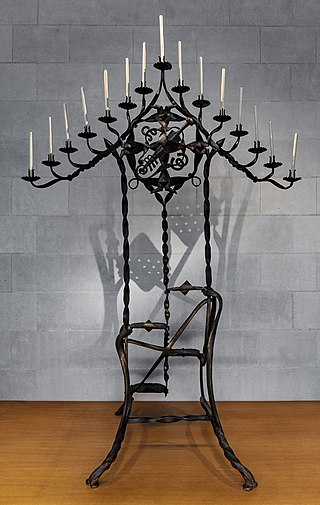
Tenebrae is a religious service of Western Christianity held during the three days preceding Easter Day, and characterized by gradual extinguishing of candles, and by a "strepitus" or "loud noise" taking place in total darkness near the end of the service.
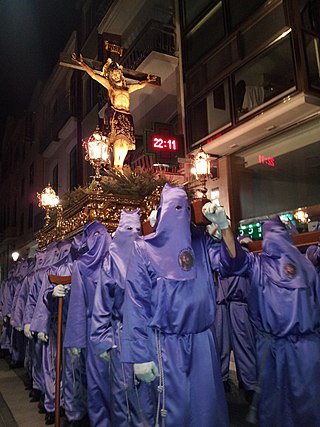
In Christianity, Holy Wednesday commemorates the Bargain of Judas as a clandestine spy among the disciples. It is also called Spy Wednesday, or Good Wednesday, and Great and Holy Wednesday.

The Mass of the Lord's Supper, also known as A Service of Worship for Maundy Thursday, is a Holy Week service celebrated on the evening of Maundy Thursday. It inaugurates the Easter Triduum, and commemorates the Last Supper of Jesus with his disciples, more explicitly than other celebrations of the Mass.
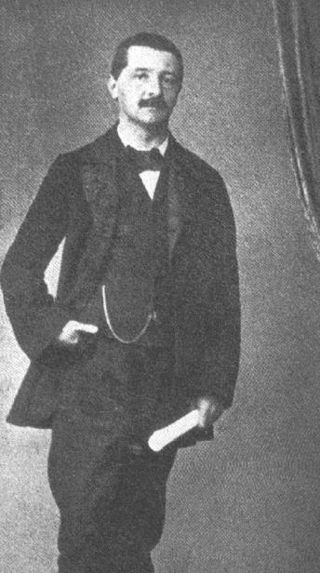
The Kronstorfer Messe, WAB 146, is a missa brevis composed by Anton Bruckner in 1843-1844.

The Messe für den Gründonnerstag, WAB 9, is a missa brevis composed by Anton Bruckner in 1844.

Ecce sacerdos magnus, WAB 13, is an 1885 sacred motet by the Austrian composer Anton Bruckner. It is a musical setting of the antiphon of the same title.
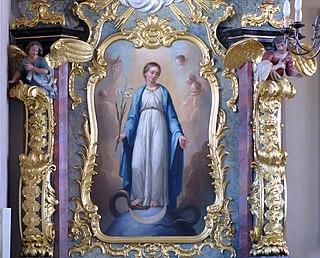
Virga Jesse, WAB 52, is a motet by the Austrian composer Anton Bruckner. It sets the gradual Virga Jesse floruit for unaccompanied mixed choir.

Vexilla regis, WAB 51, is the final motet written by the Austrian composer Anton Bruckner.
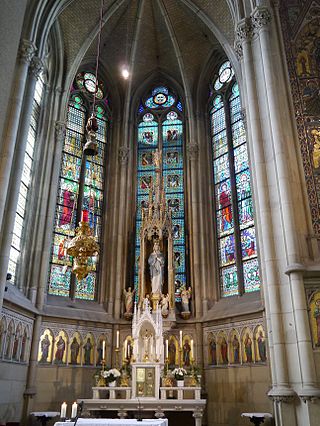
Locus iste, WAB 23, is a sacred motet composed by Anton Bruckner in 1869. The text is the Latin gradual Locus iste for the annual celebration of a church's dedication. The incipit, Locus iste a Deo factus est, translates to "This place was made by God". Bruckner set it for four unaccompanied voices, intended for the dedication of the Votivkapelle at the New Cathedral in Linz, Austria, where Bruckner had been a cathedral organist. It was the first motet that Bruckner composed in Vienna. It was published in 1886, together with three other gradual motets.

Christus factus est, WAB 11, is a sacred motet by Anton Bruckner, his third setting of the Latin gradual Christus factus est, composed in 1884. Before, Bruckner composed in 1844 a first piece on the same text as gradual of the Messe für den Gründonnerstag, and in 1873 a motet for eight-part mixed choir, three trombones, and string instruments ad libitum. The motet is an expressive setting of the gradual, influenced by Wagner's music.

Christus factus est, WAB 10, is a sacred motet by Anton Bruckner, his second setting of the Latin gradual Christus factus est, written in 1873. Several decades earlier, in 1844, he had composed another piece on the same text as gradual for the Messe für den Gründonnerstag. In 1884, Bruckner composed a third, better known setting for choir a cappella.

Os justi, WAB 30, is a sacred motet composed by Anton Bruckner in 1879. Os Justi is a Gregorian chant used as gradual of the Commune Doctorum, and as introit I and gradual II of the Commune Confessoris non Pontificis.
Tenebrae responsories are the responsories sung following the lessons of Tenebrae, the Matins services of the last three days of Holy Week: Maundy Thursday, Good Friday and Holy Saturday. Polyphonic settings to replace plainchant have been published under a various titles, including Responsoria pro hebdomada sancta.
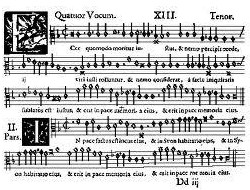
The righteous perishes are the words with which the 57th chapter of the Book of Isaiah start. In Christianity, Isaiah 57:1–2 is associated with the death of Christ, leading to liturgical use of the text at Tenebrae: the 24th responsory for Holy Week, "Ecce quomodo moritur justus", is based on this text. More generally, the text is associated with the death of loved ones and is used at burials. As such, and in other versions and translations, the Bible excerpt has been set to music.

Du bist wie eine Blume, WAB 64, is a song, which Anton Bruckner composed in 1861.

A crotalus, also known as a crotalum or clapper, is a wooden liturgical rattle or clapper that replaces altar bells during the celebration of the Tridentine Paschal Triduum at the end of Lent in the Catholic Church. It is also occasionally used during the celebration of the Ordinary Form Roman Missal during the Paschal Triduum, but its popularity decreased following the liturgical reforms of the Second Vatican Council. The crotalus is also sometimes used in Episcopal Church parishes.